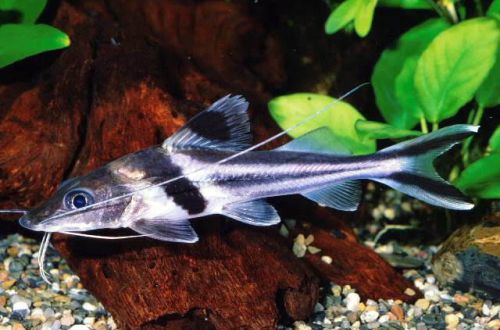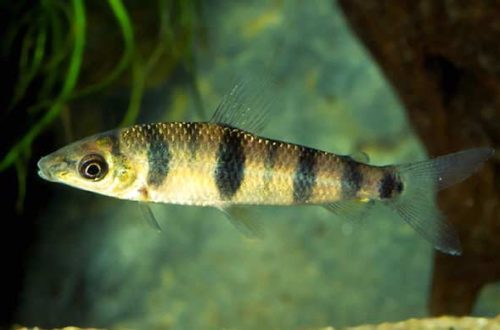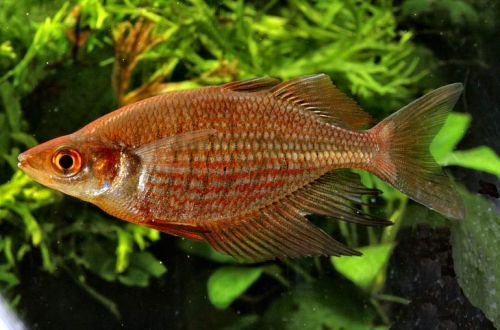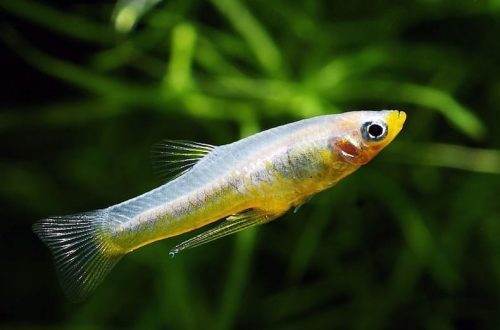
Exquisite Pimelodus
Pimelodus patterned or Exquisite Pimelodus, scientific name Pimelodus ornatus, belongs to the Pimelodidae family. One of the most beautiful catfish, it has a peaceful disposition, unpretentious diet, is relatively easy to keep if the aquarium is set up properly and a powerful filtration system is installed. However, due to its maximum size and the need for fairly expensive equipment (aquarium, filters), it may not be affordable.

Contents
Habitat
Widely distributed throughout the Amazon Basin, found in almost all countries of South America. It lives in shallow reservoirs, small rivers, tributaries of larger rivers and lakes resulting from flooding of the coastal strip during the rainy season.
Brief information:
- The volume of the aquarium – from 540 liters.
- Temperature – 22-26°C
- Value pH — 6.0–7.2
- Water hardness – soft to medium hard (2-18 dGH)
- Substrate type – sandy
- Lighting – subdued
- Brackish water – no
- Water movement – moderate, strong
- The size of the fish is up to 28 cm.
- Meals – any
- Temperament – conditionally peaceful
- Content preferably in a small group
Description
Adult individuals reach a length of up to 28 cm. A characteristic feature of the species is the alternation of light silvery and dark stripes, the latter continuing on the tail. The fins are transparent, there is a large black mark on the dorsal. The mouth has three pairs of antennae, one of which is very long and comparable in length to the body. With the help of antennae, catfish navigate and find food.
Food
A carnivorous species, in nature it feeds on small benthic invertebrates, and on occasion small fish. In a home aquarium, you can serve live, fresh or frozen foods from tubifex, bloodworms, earthworms, pieces of clams and freshwater shrimp, as well as popular dry sinking foods in the form of flakes, granules, tablets. It is important not to overfeed, Pimelodus patterned can eat until the abdomen swells, and this is fraught with digestive problems. It is advisable to feed meat food once every few days, dry food – in small portions daily.
Maintenance and care, arrangement of the aquarium
For one adult catfish, an aquarium of 540 liters or more is required, which is also enough for a small group of young Pimelodus. The design should provide enough space for swimming, a subdued level of lighting, and several appropriately sized shelters. Plants are optional, but if you plan on planting them, choose from hardy species such as Anubias, ferns, and mosses.
It is worth noting that lighting directly affects the behavior of catfish. In suitable dim light, they will actively swim around the aquarium, while in bright light, they will spend most of the time in shelter and get out of it only at night.
An efficient filtration system is essential. Fish produce a lot of waste and at the same time need high quality water, therefore, along with filtration, it is necessary to clean it weekly and replace part of the water (15–20% of the volume) with fresh water.
Behavior and Compatibility
Peaceful friendly species in relation to relatives and other fish of similar size and temperament, however, for small fish it is a direct threat. Due to illegibility in food, the latter can become an accidental victim of Pimelodus patterned. It is recommended to keep in a small group.
Breeding / breeding
In nature, catfish spawn during the rainy season and the mating season is preceded by upstream migration, which is very problematic to reproduce in a home aquarium. For sale, they are mainly bred from commercial fish farms and less often, especially for the markets of Europe and Asia, they are caught from the wild.
Fish diseases
The main cause of health problems is an unsuitable living environment. If the first symptoms are detected, you should check the water parameters and the presence of high concentrations of hazardous substances (ammonia, nitrites, nitrates, etc.), if necessary, bring the indicators back to normal and only then proceed with treatment. The exquisite Pimelodus has no scales, and its skin is very thin, so it is extremely sensitive to many common drugs. Before use, carefully read the instructions and if in doubt, reduce the dose by half. Read more about symptoms and treatments in the Aquarium Fish Diseases section.





